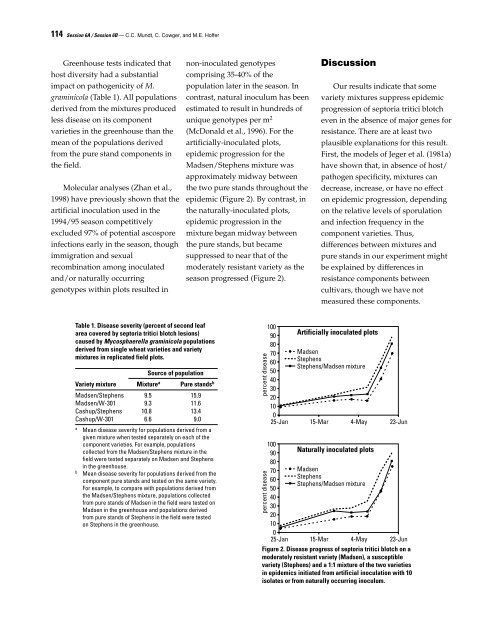Septoria and Stagonospora Diseases of Cereals - CIMMYT ...
Septoria and Stagonospora Diseases of Cereals - CIMMYT ...
Septoria and Stagonospora Diseases of Cereals - CIMMYT ...
Create successful ePaper yourself
Turn your PDF publications into a flip-book with our unique Google optimized e-Paper software.
Session 6A / Session 6B — C.C. Mundt, C. Cowger, <strong>and</strong> M.E. H<strong>of</strong>fer<br />
114<br />
Greenhouse tests indicated that non-inoculated genotypes<br />
host diversity had a substantial comprising 35-40% <strong>of</strong> the<br />
impact on pathogenicity <strong>of</strong> M. population later in the season. In<br />
graminicola (Table 1). All populations contrast, natural inoculum has been<br />
derived from the mixtures produced estimated to result in hundreds <strong>of</strong><br />
less disease on its component unique genotypes per m<br />
varieties in the greenhouse than the<br />
mean <strong>of</strong> the populations derived<br />
from the pure st<strong>and</strong> components in<br />
the field.<br />
Molecular analyses (Zhan et al.,<br />
1998) have previously shown that the<br />
artificial inoculation used in the<br />
1994/95 season competitively<br />
excluded 97% <strong>of</strong> potential ascospore<br />
infections early in the season, though<br />
immigration <strong>and</strong> sexual<br />
recombination among inoculated<br />
<strong>and</strong>/or naturally occurring<br />
genotypes within plots resulted in<br />
2<br />
(McDonald et al., 1996). For the<br />
artificially-inoculated plots,<br />
epidemic progression for the<br />
Madsen/Stephens mixture was<br />
approximately midway between<br />
the two pure st<strong>and</strong>s throughout the<br />
epidemic (Figure 2). By contrast, in<br />
the naturally-inoculated plots,<br />
epidemic progression in the<br />
mixture began midway between<br />
the pure st<strong>and</strong>s, but became<br />
suppressed to near that <strong>of</strong> the<br />
moderately resistant variety as the<br />
season progressed (Figure 2).<br />
Table 1. Disease severity (percent <strong>of</strong> second leaf<br />
area covered by septoria tritici blotch lesions)<br />
caused by Mycosphaerella graminicola populations<br />
derived from single wheat varieties <strong>and</strong> variety<br />
mixtures in replicated field plots.<br />
Source <strong>of</strong> population<br />
Variety mixture Mixturea Pure st<strong>and</strong>sb Madsen/Stephens 9.5 15.9<br />
Madsen/W-301 9.3 11.6<br />
Cashup/Stephens 10.8 13.4<br />
Cashup/W-301 6.6 9.0<br />
a Mean disease severity for populations derived from a<br />
given mixture when tested separately on each <strong>of</strong> the<br />
component varieties. For example, populations<br />
collected from the Madsen/Stephens mixture in the<br />
field were tested separately on Madsen <strong>and</strong> Stephens<br />
in the greenhouse.<br />
b Mean disease severity for populations derived from the<br />
component pure st<strong>and</strong>s <strong>and</strong> tested on the same variety.<br />
For example, to compare with populations derived from<br />
the Madsen/Stephens mixture, populations collected<br />
from pure st<strong>and</strong>s <strong>of</strong> Madsen in the field were tested on<br />
Madsen in the greenhouse <strong>and</strong> populations derived<br />
from pure st<strong>and</strong>s <strong>of</strong> Stephens in the field were tested<br />
on Stephens in the greenhouse.<br />
percent disease<br />
percent disease<br />
100<br />
90<br />
80<br />
70<br />
60<br />
50<br />
40<br />
30<br />
20<br />
10<br />
0<br />
25-Jan<br />
100<br />
90<br />
80<br />
70<br />
60<br />
50<br />
40<br />
Discussion<br />
Our results indicate that some<br />
variety mixtures suppress epidemic<br />
progression <strong>of</strong> septoria tritici blotch<br />
even in the absence <strong>of</strong> major genes for<br />
resistance. There are at least two<br />
plausible explanations for this result.<br />
First, the models <strong>of</strong> Jeger et al. (1981a)<br />
have shown that, in absence <strong>of</strong> host/<br />
pathogen specificity, mixtures can<br />
decrease, increase, or have no effect<br />
on epidemic progression, depending<br />
on the relative levels <strong>of</strong> sporulation<br />
<strong>and</strong> infection frequency in the<br />
component varieties. Thus,<br />
differences between mixtures <strong>and</strong><br />
pure st<strong>and</strong>s in our experiment might<br />
be explained by differences in<br />
resistance components between<br />
cultivars, though we have not<br />
measured these components.<br />
Artificially inoculated plots<br />
Madsen<br />
Stephens<br />
Stephens/Madsen mixture<br />
15-Mar 4-May 23-Jun<br />
Naturally inoculated plots<br />
Madsen<br />
Stephens<br />
Stephens/Madsen mixture<br />
30<br />
20<br />
10<br />
0<br />
25-Jan 15-Mar 4-May 23-Jun<br />
Figure 2. Disease progress <strong>of</strong> septoria tritici blotch on a<br />
moderately resistant variety (Madsen), a susceptible<br />
variety (Stephens) <strong>and</strong> a 1:1 mixture <strong>of</strong> the two varieties<br />
in epidemics initiated from artificial inoculation with 10<br />
isolates or from naturally occurring inoculum.









